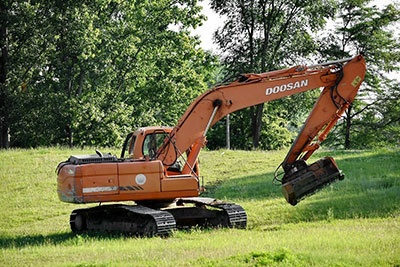Landscape Grading?
A Value Question
Moving the Earth
In residential landscape design situations, it is not always required to hire skilled labor to perform landscape grading. In most cases, you are either purchasing a new home from a builder or are working with an existing landscape (often a fiasco!), and adjusting these existing gardens to fit your design sensibilities.
In both of these situations, it is likely that the ground is either level, or reasonably comfortable to work with as a foundation.
In most new home purchase situations, the builder has already graded and leveled the site, and in many cases has installed a minimal landscape, especially in the front garden areas.

In most situations where you are purchasing an existing home, again, the leveling of land and basic installations are completed. In many of these situations, the basic foundations already set are very likely to be workable with just a little bit of imagination applied. Even many of the less than desirable “opportunities” you have inherited in such a situation can be easily resolved by revising, updating, or repairing,
without engaging a landscape contractor or designer.
However, there are some situations where a contractor should be engaged to complete the landscape grading for you, as when the existing topography or installations are not satisfactory and major rework is required. When faced with such a situation, look closely at your circumstances, skills and motivation, before jumping into a do it yourself revision of your garden.
I’ve dedicated this page to helping you make that decision by informing you of some of the potential concerns and requirements as you begin to contemplate landscape grading of your property. Preparation before making any major design decisions that involve moving the earth in large quantities is imperative for both your personal safety and your financial health.
Deciding whether to take on the task of Landscape Grading can be a daunting task! There is much involved in this decision, everything from aching backs, to fear of failure, to potentially exorbitant costs. Deciding if you want to take this task on requires a basic understanding of the processes, knowing what the alternatives are, and then tailoring your decision to match your motivations and capabilities.
Why Is Landscape Grading Important?

Reinforcing Aesthetics
Besides the plants you will eventually add to your landscape, the land is one of the most important design tools in the designers quiver. The design principles we’ve addressed elsewhere, such a s rhythm, balance, repetition, scale and proportion may be used to create dramatic design effects!
Soil grading for terraces, steps, slopes, and embankments can highly affect the ambiance of your garden, and start you off with a firm foundation, literally!
Providing a Foundation for Landscape Elements
Landscape grading is often undertaken for the purpose of fashioning specific landscape elements, such as driveways and patios, and in implementing techniques to modify land surfaces, such as stairs, slopes, and embankments.
Improving Drainage
Protecting the land and your home from water is one major reason to undertake land grading efforts. Creating slopes away from the house, constructing retention ponds, and diffusing water in order to reduce erosion are all important considerations that may bring you to the point of deciding that land grading is important to undertake.
Increasing the Stability of the Land
Creating stability for some landscape installations or building landscape foundations is often a consideration. Installations such as rock walls, manmade embankments, or water features may require you to reinforce an area of the landscape. Redirecting water, improving soil, and adding stone and large rock to your landscape can go a long way toward creating this stability.
Directing Traffic Circulation
The topography of your landscape can greatly affect the way individuals move across the property. Berms, ponds, paths and driveways all re-direct traffic. Large flat areas encourage wandering, while undulating surfaces tend to direct traffic into lower areas. People like to do the least work possible! That includes climbing that tiny little hill in your yard. You may also wish to direct traffic toward a front entrance, when multiple doors face the property entrance. Techniques involving grading of your land can highly reinforce both aesthetic and practical landscape elements.
The following video by C&C; Landscaping does an excellent job of presenting the benefits of landscape grading, with some wonderful before and after shots that make my mouth water!
The Landscape Grading Process
Measuring and Design
As a foundation for the landscape grading work you will do, you will first need to define a plan. Measuring your property and understanding how grading the soil will impact your landscape design will help you make decisions about grading your property. Before renting that bulldozer, know what you want to accomplish.
You can plan improvements to landscape drainage, add aesthetically pleasing lines, soil amendments, or stability for desired landscape installations, and install irrigation systems during this phase of the process.
Removing Topsoil
Topsoil is a precious commodity. It may take a thousand years for nature to create a few centimeters of healthy, living topsoil. So it is best to remove topsoils and stockpile them for re-installation after your land grading preparation steps are completed.
Soil Excavation
Some properties or design decisions will require you to excavate soil. Installations such as swimming pools, for example, require hollowing out an area. Larger scale projects may require an excavator to move dirt from a higher spot in the garden to a lower area or to redefine surfaces in a major way that requires heavy duty excavation.

Rough Grading
Rough grading is the process of moving large quantities of dirt in order to shape the foundation of the land. This is the time to cut into that big hill at the side of your property so you can add the new driveway. It is also the time to set the foundation for hills, terraces, large swales, or drainage systems.
Irrigation Installation
Add irrigation systems to your property now as well, if you are going to do so. The earth is open and exposed, ready for you to impose your will. Irrigation systems can be a huge asset in drier areas of the world, so consider this carefully. You will never have a better opportunity to install these systems.
Backfilling Soil
Once the land has been manipulated, it is time to add additional soil back in. Topsoil needs to be spread across the planting areas, irrigation and drainage ditches refilled. Often, in the process of land grading, soils are compacted and soil structure destroyed while the property is lying bare and unplanted. In this step, you are setting the foundation for the future health of your garden landscape.
Finish Grading
Finish grading is the precise grading that makes your property look aesthetically pleasing. Leveling, smoothing, and measuring to specifications are the order of the day. This final preparation sets the foundation for your property to support those new landscape elements such as patios, driveways, and lawns.
Here is an entertaining short video that records a homeowner using a small bulldozer, called a Ditchwitch, to do the finish grading for his yard area.
Jobs such as this are well within the capabilities of the average homeowner, while jobs such as that shown in the C&C; video above are best left to landscape contractors who are equipped for large scale landscape grading projects.
Home Landscape Designing Considerations
Mother Nature
Conditions of your property may dictate how your landscape design will play out. Mother Nature wins all battles, so don’t try to work against the general contours of your property. It is expensive, and sometimes out of your control to completely reshape your property. Look for the assets and preserve them, while eliminating the negatives.
Your climate, existing land features, and different soil types will dictate what you can do for the most part. It is a big mistake to ignore these factors in your landscape grading efforts.
No single factor affects your final results more than the grade of your property. It can make or break your landscape. Landscape Design and Landscape Grading are intimately connected.
As you can see, there are a number of factors you should consider when making a decision to do your own landscape grading. Evaluate carefully to decide if it is in your best interests to hire earth moving services to do the job for you.
Local Laws and Permits
Know your local law and permit requirements!
Grading activities such as digging, moving large amounts of soil, and trenching often require permits before being undertaken. Get to know your legal requirements by visiting your county or municipal offices to obtain relevant regulatory information.
There may be bylaws dictating requirements for connecting to storm drains, constructing decks, patios and railings, or altering property accesses. You may have homeowners association restrictions to consider.
All of these have potential to cause you some major headaches if you plow ahead without considering the implications. Avoid those unexpected bombshells!
Locate your utilities and existing water lines
Many the homeowner who will come to regret digging into the soil without knowing what is underneath! In our modern times, utility lines, water lines, gas lines and fiber optics are often buried only a few inches under the surface of your property.
It is inconvenient and sometimes dangerous to cut into or otherwise disrupt these services. So don’t ignore this!
You can find out where these services are located by contacting your local service companies. They will often come out and mark these installations so that they are easier to plan for and to avoid disturbing services.
If you find that these installations are in inconvenient places on your property, you will need to obtain permits and skilled help to relocate them.
Estimate Costs
It is not healthy for your budget to go unaware into a landscape grading effort!
The more manipulation you need to do the more cost is generated for your project. If you need to rent earth moving machines to do the job, more cost is involved. Water management solutions, such as irrigation and subsurface drainage systems, can be pricey to install, so KNOW YOUR LIMITS.
Don’t be caught in a situation where you are unable to finish your landscaping job because you didn’t count the cost first!
